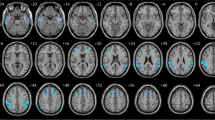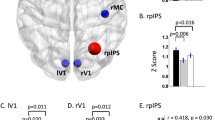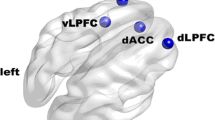Abstract
To investigate resting-state connectivity and further understand directional aspects of implicit alterations in presbycusis patients, we used degree centrality (DC) and Granger causality analysis (GCA) to detect functional hubs of the whole-brain network and then analyze directional connectivity. Resting-state functional magnetic resonance imaging (fMRI) scans were performed on 40 presbycusis patients and 40 healthy controls matched for age, gender, and education. We used DC analysis and GCA to characterize abnormal brain networks in presbycusis patients. The associations of network centrality and directed functional connectivity (FC) with clinical measures of presbycusis were also examined according to the above results. We found that the network centrality of left frontal middle gyrus (MFG) was significantly lower than that of healthy control group. Unidirectionally, the left MFG revealed increased directional connectivity to the left superior frontal gyrus (SFG), while the left MFG exhibited decreased directional connectivity to the left middle temporal gyrus (MTG) and right lingual gyrus (LinG). And the decreased directional connectivity was found from the left precentral gyrus (PrCG) to the left MFG. In addition, the Trail-Making Test B (TMT-B) score was negatively correlated with the decreased DC of the left MFG (r = −0.359, p = 0.032). Resting-state fMRI provides a novel method for identifying aberrant brain network architecture. These results primarily indicate altered functional hubs and abnormal frontal lobe connectivity patterns that may further reflect executive dysfunction in patients with presbycusis.




Similar content being viewed by others
References
Ardila, A., Bernal, B., & Rosselli, M. (2016). How localized are language brain areas? A review of Brodmann areas involvement in Oral language. Archives of Clinical Neuropsychology, 31(1), 112–122. https://doi.org/10.1093/arclin/acv081.
Ashburner, J., & Friston, K. J. (2005). Unified segmentation. Neuroimage, 26, 839–851. https://doi.org/10.1016/j.neuroimage.2005.02.018
Bernarding, C., Strauss, D. J., Hannemann, R., Seidler, H., & Corona-Strauss, F. I. (2017). Neurodynamic evaluation of hearing aid features using EEG correlates of listening effort. Cognitive Neurodynamics, 11(3), 203–215. https://doi.org/10.1007/s11571-017-9425-5.
Brennan, N. P., Peck, K. K., & Holodny, A. (2016). Language mapping using fMRI and direct cortical stimulation for brain tumor surgery: The good, the bad, and the questionable. Topics in Magnetic Resonance Imaging, 25(1), 1–10. https://doi.org/10.1097/RMR.0000000000000074.
Brucki, S. M., & Rocha, M. S. (2004). Category fluency test: Effects of age, gender and education on total scores, clustering and switching in Brazilian Portuguese-speaking subjects. Brazilian Journal of Medical and Biological Research, 37(12), 1771–1777. https://doi.org/10.1590/s0100-879x2004001200002.
Buckner, R. L., Sepulcre, J., Talukdar, T., Krienen, F. M., Liu, H., Hedden, T., Andrews-Hanna, J. R., Sperling, R. A., & Johnson, K. A. (2009). Cortical hubs revealed by intrinsic functional connectivity: Mapping, assessment of stability, and relation to Alzheimer's disease. The Journal of Neuroscience, 29(6), 1860–1873. https://doi.org/10.1523/JNEUROSCI.5062-08.2009.
Carter, C. S., Mintun, M., Nichols, T., & Cohen, J. D. (1997). Anterior cingulate gyrus dysfunction and selective attention deficits in schizophrenia: [15O]H2O PET study during single-trial Stroop task performance. The American Journal of Psychiatry, 154(12), 1670–1675. https://doi.org/10.1176/ajp.154.12.1670.
Chen, X., Wang, M., Deng, Y., Liang, Y., Li, J., & Chen, S. (2016a). Language processing of auditory cortex revealed by functional magnetic resonance imaging in presbycusis patients. Acta Oto-Laryngologica, 136(2), 113–119. https://doi.org/10.3109/00016489.2015.1049662.
Chen, Y. C., Feng, Y., Xu, J. J., Mao, C. N., Xia, W., Ren, J., & Yin, X. (2016b). Disrupted brain functional network architecture in chronic tinnitus patients. Frontiers in Aging Neuroscience, 8, 174. https://doi.org/10.3389/fnagi.2016.00174.
Chen, Y. C., Chen, H., Jiang, L., Bo, F., Xu, J. J., Mao, C. N., Salvi, R., Yin, X., Lu, G., & Gu, J. P. (2018). Presbycusis disrupts spontaneous activity revealed by resting-state functional MRI. Frontiers in Behavioral Neuroscience, 12, 44. https://doi.org/10.3389/fnbeh.2018.00044.
Chen, Y. C., Yong, W., Xing, C., Feng, Y., Haidari, N. A., Xu, J. J., Gu, J. P., Yin, X., & Wu, Y. (2020). Directed functional connectivity of the hippocampus in patients with presbycusis. Brain Imaging and Behavior, 14(3), 917–926. https://doi.org/10.1007/s11682-019-00162-z.
Dai, Z., Yan, C., Li, K., Wang, Z., Wang, J., Cao, M., Lin, Q., Shu, N., Xia, M., Bi, Y., & He, Y. (2015). Identifying and mapping connectivity patterns of brain network hubs in Alzheimer's disease. Cerebral Cortex, 25(10), 3723–3742. https://doi.org/10.1093/cercor/bhu246.
Desseilles, M., Balteau, E., Sterpenich, V., Dang-Vu, T. T., Darsaud, A., Vandewalle, G., Albouy, G., Salmon, E., Peters, F., Schmidt, C., Schabus, M., Gais, S., Degueldre, C., Phillips, C., Luxen, A., Ansseau, M., Maquet, P., & Schwartz, S. (2009). Abnormal neural filtering of irrelevant visual information in depression. The Journal of Neuroscience, 29(5), 1395–1403. https://doi.org/10.1523/JNEUROSCI.3341-08.2009.
du Boisgueheneuc, F., Levy, R., Volle, E., Seassau, M., Duffau, H., Kinkingnehun, S., et al. (2006). Functions of the left superior frontal gyrus in humans: A lesion study. Brain, 129(Pt 12), 3315–3328. https://doi.org/10.1093/brain/awl244.
Fitzhugh, M. C., Hemesath, A., Schaefer, S. Y., Baxter, L. C., & Rogalsky, C. (2019). Functional connectivity of Heschl's Gyrus associated with age-related hearing loss: A resting-state fMRI study. Frontiers in Psychology, 10, 2485. https://doi.org/10.3389/fpsyg.2019.02485.
Friston, K., Moran, R., & Seth, A. K. (2013). Analysing connectivity with granger causality and dynamic causal modelling. Current Opinion in Neurobiology, 23(2), 172–178. https://doi.org/10.1016/j.conb.2012.11.010.
Gao, F., Wang, G., Ma, W., Ren, F., Li, M., Dong, Y., Liu, C., Liu, B., Bai, X., Zhao, B., & Edden, R. A. E. (2015). Decreased auditory GABA+ concentrations in presbycusis demonstrated by edited magnetic resonance spectroscopy. Neuroimage, 106, 311–316. https://doi.org/10.1016/j.neuroimage.2014.11.023.
Gates, G. A., & Mills, J. H. (2005). Presbycusis. Lancet, 366(9491), 1111–1120. https://doi.org/10.1016/S0140-6736(05)67423-5.
Guest, H., Munro, K. J., Prendergast, G., Howe, S., & Plack, C. J. (2017). Tinnitus with a normal audiogram: Relation to noise exposure but no evidence for cochlear synaptopathy. Hearing Research, 344, 265–274. https://doi.org/10.1016/j.heares.2016.12.002.
Gunning-Dixon, F. M., & Raz, N. (2003). Neuroanatomical correlates of selected executive functions in middle-aged and older adults: A prospective MRI study. Neuropsychologia, 41(14), 1929–1941. https://doi.org/10.1016/s0028-3932(03)00129-5.
Hale, J. B., Hoeppner, J.-A. B., & Assessment, C.A.F.J.J.o.P. (2002). Analyzing. Digit Span Components for Assessment of Attention Processes., 20(2), 128–143.
Husain, F. T., Carpenter-Thompson, J. R., & Schmidt, S. A. (2014). The effect of mild-to-moderate hearing loss on auditory and emotion processing networks. Frontiers in Systems Neuroscience, 8, 10. https://doi.org/10.3389/fnsys.2014.00010.
Kamada, K., Sawamura, Y., Takeuchi, F., Kuriki, S., Kawai, K., Morita, A., & Todo, T. (2007). Expressive and receptive language areas determined by a non-invasive reliable method using functional magnetic resonance imaging and magnetoencephalography. Neurosurgery, 60(2), 296–305; discussion 305-296. https://doi.org/10.1227/01.NEU.0000249262.03451.0E.
Khalfa, S., Dubal, S., Veuillet, E., Perez-Diaz, F., Jouvent, R., & Collet, L. (2002). Psychometric normalization of a hyperacusis questionnaire. ORL: Journal for Otorhinolaryngology and Its Related Specialties, 64(6), 436–442. https://doi.org/10.1159/000067570.
Kragel, P. A., Kano, M., Van Oudenhove, L., Ly, H. G., Dupont, P., Rubio, A., et al. (2018). Generalizable representations of pain, cognitive control, and negative emotion in medial frontal cortex. Nature Neuroscience, 21(2), 283–289. https://doi.org/10.1038/s41593-017-0051-7.
Li, W., Qin, W., Liu, H., Fan, L., Wang, J., Jiang, T., & Yu, C. (2013). Subregions of the human superior frontal gyrus and their connections. Neuroimage, 78, 46–58. https://doi.org/10.1016/j.neuroimage.2013.04.011.
Lin, F. R., Thorpe, R., Gordon-Salant, S., & Ferrucci, L. (2011). Hearing loss prevalence and risk factors among older adults in the United States. The Journals of Gerontology. Series A, Biological Sciences and Medical Sciences, 66(5), 582–590. https://doi.org/10.1093/gerona/glr002.
Lopez-Escamez, J. A., Carey, J., Chung, W. H., Goebel, J. A., Magnusson, M., Mandala, M., et al. (2015). Diagnostic criteria for Meniere's disease. Journal of Vestibular Research, 25(1), 1–7. https://doi.org/10.3233/VES-150549.
Lu, J., Li, D., Li, F., Zhou, A., Wang, F., Zuo, X., Jia, X. F., Song, H., & Jia, J. (2011). Montreal cognitive assessment in detecting cognitive impairment in Chinese elderly individuals: A population-based study. Journal of Geriatric Psychiatry and Neurology, 24(4), 184–190. https://doi.org/10.1177/0891988711422528.
Ma, W., Li, M., Gao, F., Zhang, X., Shi, L., Yu, L., Zhao, B., Chen, W., Wang, G., & Wang, X. (2016). DTI analysis of Presbycusis using voxel-based analysis. AJNR. American Journal of Neuroradiology, 37(11), 2110–2114. https://doi.org/10.3174/ajnr.A4870.
Meppelink, A. M., de Jong, B. M., Renken, R., Leenders, K. L., Cornelissen, F. W., & van Laar, T. (2009). Impaired visual processing preceding image recognition in Parkinson's disease patients with visual hallucinations. Brain, 132(Pt 11), 2980–2993. https://doi.org/10.1093/brain/awp223.
Micarelli, A., Chiaravalloti, A., Viziano, A., Danieli, R., Schillaci, O., & Alessandrini, M. (2017). Early cortical metabolic rearrangement related to clinical data in idiopathic sudden sensorineural hearing loss. Hearing Research, 350, 91–99. https://doi.org/10.1016/j.heares.2017.04.011.
Mudar, R. A., & Husain, F. T. (2016). Neural alterations in acquired age-related hearing loss. Frontiers in Psychology, 7, 828. https://doi.org/10.3389/fpsyg.2016.00828.
Ouda, L., Profant, O., & Syka, J. (2015). Age-related changes in the central auditory system. Cell and Tissue Research, 361(1), 337–358. https://doi.org/10.1007/s00441-014-2107-2.
Panza, F., Solfrizzi, V., & Logroscino, G. (2015). Age-related hearing impairment-a risk factor and frailty marker for dementia and AD. Nature Reviews. Neurology, 11(3), 166–175. https://doi.org/10.1038/nrneurol.2015.12.
Pichora-Fuller, M. K., Kramer, S. E., Eckert, M. A., Edwards, B., Hornsby, B. W., Humes, L. E., et al. (2016). Hearing impairment and cognitive energy: The framework for understanding effortful listening (FUEL). Ear and Hearing, 37(Suppl 1), 5S–27S. https://doi.org/10.1097/AUD.0000000000000312.
Profant, O., Tintera, J., Balogova, Z., Ibrahim, I., Jilek, M., & Syka, J. (2015). Functional changes in the human auditory cortex in ageing. PLoS One, 10(3), e0116692. https://doi.org/10.1371/journal.pone.0116692.
Puschmann, S., & Thiel, C. M. (2017). Changed crossmodal functional connectivity in older adults with hearing loss. Cortex, 86, 109–122. https://doi.org/10.1016/j.cortex.2016.10.014.
Ren, F., Ma, W., Li, M., Sun, H., Xin, Q., Zong, W., Chen, W., Wang, G., Gao, F., & Zhao, B. (2018). Gray matter atrophy is associated with cognitive impairment in patients with Presbycusis: A comprehensive morphometric study. Frontiers in Neuroscience, 12, 744. https://doi.org/10.3389/fnins.2018.00744.
Rosano, C., Chang, Y. F., Kuller, L. H., Guralnik, J. M., Studenski, S. A., Aizenstein, H. J., Gianaros, P. J., Lopez, O. L., Longstreth Jr., W. T., & Newman, A. B. (2013). Long-term survival in adults 65 years and older with white matter hyperintensity: Association with performance on the digit symbol substitution test. Psychosomatic Medicine, 75(7), 624–631. https://doi.org/10.1097/PSY.0b013e31829c1df2.
Rosemann, S., & Thiel, C. M. (2018). Audio-visual speech processing in age-related hearing loss: Stronger integration and increased frontal lobe recruitment. Neuroimage, 175, 425–437. https://doi.org/10.1016/j.neuroimage.2018.04.023.
Rottschy, C., Langner, R., Dogan, I., Reetz, K., Laird, A. R., Schulz, J. B., Fox, P. T., & Eickhoff, S. B. (2012). Modelling neural correlates of working memory: A coordinate-based meta-analysis. Neuroimage, 60(1), 830–846. https://doi.org/10.1016/j.neuroimage.2011.11.050.
Rutherford, B. R., Brewster, K., Golub, J. S., Kim, A. H., & Roose, S. P. (2018). Sensation and psychiatry: Linking age-related hearing loss to late-life depression and cognitive decline. The American Journal of Psychiatry, 175(3), 215–224. https://doi.org/10.1176/appi.ajp.2017.17040423.
Samton, J. B., Ferrando, S. J., Sanelli, P., Karimi, S., Raiteri, V., & Barnhill, J. W. (2005). The clock drawing test: Diagnostic, functional, and neuroimaging correlates in older medically ill adults. The Journal of Neuropsychiatry and Clinical Neurosciences, 17(4), 533–540. https://doi.org/10.1176/jnp.17.4.533.
Sanchez-Cubillo, I., Perianez, J. A., Adrover-Roig, D., Rodriguez-Sanchez, J. M., Rios-Lago, M., Tirapu, J., et al. (2009). Construct validity of the trail making test: Role of task-switching, working memory, inhibition/interference control, and visuomotor abilities. Journal of the International Neuropsychological Society, 15(3), 438–450. https://doi.org/10.1017/S1355617709090626.
Shin, M. S., Park, S. Y., Park, S. R., Seol, S. H., & Kwon, J. S. (2006). Clinical and empirical applications of the Rey-Osterrieth complex figure test. Nature Protocols, 1(2), 892–899. https://doi.org/10.1038/nprot.2006.115.
Yan, C. G., Craddock, R. C., Zuo, X. N., Zang, Y. F., & Milham, M. P. (2013). Standardizing the intrinsic brain: Towards robust measurement of inter-individual variation in 1000 functional connectomes. Neuroimage, 80, 246–262. https://doi.org/10.1016/j.neuroimage.2013.04.081.
Zhao, Q., Lv, Y., Zhou, Y., Hong, Z., & Guo, Q. (2012). Short-term delayed recall of auditory verbal learning test is equivalent to long-term delayed recall for identifying amnestic mild cognitive impairment. PLoS One, 7(12), e51157. https://doi.org/10.1371/journal.pone.0051157.
Zhuo, C., Zhu, J., Qin, W., Qu, H., Ma, X., Tian, H., Xu, Q., & Yu, C. (2014). Functional connectivity density alterations in schizophrenia. Frontiers in Behavioral Neuroscience, 8, 404. https://doi.org/10.3389/fnbeh.2014.00404.
Zung, W. W. (1971). A rating instrument for anxiety disorders. Psychosomatics, 12(6), 371–379. https://doi.org/10.1016/S0033-3182(71)71479-0.
Zung, W. W. K. (1986). Zung self-rating depression scale and depression status inventory. In N. Sartorius & T. A. Ban (Eds.), Assessment of depression (pp. 221–231). Berlin: Springer. https://doi.org/10.1007/978-3-642-70486-4n_21.
Zuo, X. N., & Xing, X. X. (2014). Test-retest reliabilities of resting-state FMRI measurements in human brain functional connectomics: A systems neuroscience perspective. Neuroscience and Biobehavioral Reviews, 45, 100–118. https://doi.org/10.1016/j.neubiorev.2014.05.009.
Zuo, X. N., Ehmke, R., Mennes, M., Imperati, D., Castellanos, F. X., Sporns, O., & Milham, M. P. (2012). Network centrality in the human functional connectome. Cerebral Cortex, 22(8), 1862–1875. https://doi.org/10.1093/cercor/bhr269.
Funding
This work was supported by the National Natural Science Foundation of China (No. 81601477), Youth Medical Talents of Jiangsu Province (No. QNRC2016062), 14th “Six Talent Peaks” Project of Jiangsu Province (No. YY-079), Nanjing Outstanding Youth Fund (No. JQX17006), and 333 High-level Talents Training Project of Jiangsu Province (No. BRA2019122).
Author information
Authors and Affiliations
Corresponding authors
Ethics declarations
Conflict of interest
The authors declare that there is no potential conflict of interests regarding the publication of this paper.
Ethical approval
The current study was approved by the Research Ethics Committee of the Nanjing Medical University.
Informed consent
Informed consent was obtained from all individual participants included in the study.
Additional information
Publisher’s note
Springer Nature remains neutral with regard to jurisdictional claims in published maps and institutional affiliations.
Rights and permissions
About this article
Cite this article
Xing, C., Chen, YC., Tong, Z. et al. Aberrant brain functional hubs and causal connectivity in presbycusis. Brain Imaging and Behavior 15, 453–463 (2021). https://doi.org/10.1007/s11682-020-00386-4
Published:
Issue Date:
DOI: https://doi.org/10.1007/s11682-020-00386-4




